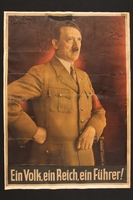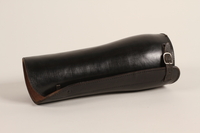Overview
- Brief Narrative
- Black and white print depicting concentration camp barracks created by an unknown artist with the initials FK in early 1945. Many prisoners, and liberating soldiers took it upon themselves to record their experiences, preserve their memories and show the world what happened. Creations range from the deeply personal responses of survivors to the more documentary approach of official war artist pieces. Some made drawings of the prisoners and life in the camps, while others created art during and after liberation. Children as well as adults documented events of the Holocaust through art. In some circumstances, imprisoned artists were able to create sketches and paintings for guards, earning extra food or other benefits as a reward, which helped some to survive life in the camps. A number of the survivors turned to art as an outlet for their trauma.
- Date
-
depiction:
1945 January 11-1945 November 01
- Geography
-
depiction:
Europe
- Credit Line
- United States Holocaust Memorial Museum Collection
- Signature
- front bottom right image, printed, black ink : FK 11.1.45 [FK January 11 1945]
- Contributor
-
Artist:
FK
Physical Details
- Classification
-
Art
- Category
-
Prints
- Object Type
-
Prints (lcsh)
- Physical Description
- Small black and white print centered on a large, faded, off white, rectangular paper, depicting two rows of single story, square barracks with pitched roofs and utility posts with a long straight path in the center. All the barracks have utility poles and three connected windows, the closest four have their center window propped open. A small drainage ditch runs parallel on each side of the path and each barrack has a plank footbridge crossing it. On the left, a plank sidewalk platform runs parallel to the center path and a tall utility pole stands in the distance. A tall tree with leafless branches has grown out of the ditch on the right. The artist’s initials and date are on the bottom right of the image.
- Dimensions
- overall: Height: 7.250 inches (18.415 cm) | Width: 10.500 inches (26.67 cm)
- Materials
- overall : paper, ink
Rights & Restrictions
- Conditions on Access
- No restrictions on access
- Conditions on Use
- No restrictions on use
Keywords & Subjects
Administrative Notes
- Legal Status
- Permanent Collection
- Provenance
- The print was acquired by the United States Holocaust Memorial Museum in 2003.
- Funding Note
- The cataloging of this artifact has been supported by a grant from the Conference on Jewish Material Claims Against Germany.
- Record last modified:
- 2023-06-13 14:15:07
- This page:
- https://collections.ushmm.org/search/catalog/irn516187
Download & Licensing
In-Person Research
- By Appointment
- Request 21 Days in Advance of Visit
- Plan a Research Visit
- Request to See This Object
Contact Us
Also in Third Reich propaganda collection
The collection consists of a banner, a pair of gaiters, a poster, documents, publications, and prints relating to life in Germany under the Third Reich, from 1933-1945.
Date: approximately 1934-1965

Color poster with a portrait of Hitler and the Nazi slogan: Ein Volk, ein Reich, ein Fuhrer!
Object
Color poster of an iconic painting of the Fuhrer, Adolf Hitler, printed in Germany during the Third Reich, 1933-1945. The original painting was created by Heinrich Knirr in 1935-1936, and was based on a photograph taken by Heinrich Hoffman in 1935. Hitler approved the image and it was widely used on Nazi propaganda pieces and was very popular. The slogan Ein Volk, ein Reich, ein Fuhrer was one of the central slogans used by Hitler and the Nazi Party. Nazi propaganda portrayed their leader (Fuhrer) as the living embodiment of the German nation and people. This slogan reinforced the cult of Hitler and the sense of destiny that the Party claimed made him the savior of Germany and father of the German people.

Pair of black leather gaiters
Object
Pair of black leather half chaps which were worn with short boots to protect the lower legs, inscribed with a name and a German city. They are similar to gaiters made in 1920, but they are undated.
Long, white banner with the Nazi Party slogan Ein Volk - Ein Reich - Ein Fuhrer
Object
Large banner with the slogan Ein Volk - Ein Reich - Ein Fuhrer [One People - One Country - One Leader], a central slogan of Hitler and the Nazi Party. The hand made banner is very long and narrow, with three foot posts at each end, perhaps to carry it during marches and parades. Nazi propaganda portrayed Hitler, their leader (Führer), as the living embodiment of the German nation and people. This slogan reinforced the cult of Hitler and the sense of destiny that the Party claimed made him the savior of Germany and father of the German people.
Book
Object
Book
Object
Book
Object
Black and white print of five rows of multi-unit barracks on grass
Object
Black and white print depicting concentration camp barracks created by an unknown artist with the initials FK in late 1944. Many prisoners and liberating soldiers took it upon themselves to record their experiences, preserve their memories and show the world what happened. Creations range from the deeply personal responses of survivors to the more documentary approach of official war artist pieces. Some made drawings of the prisoners and life in the camps, while others created art during and after liberation. Children as well as adults documented events of the Holocaust through art. In some circumstances, imprisoned artists were able to create sketches and paintings for guards, earning extra food or other benefits as a reward, which helped some to survive life in the camps. A number of the survivors turned to art as an outlet for their trauma.



